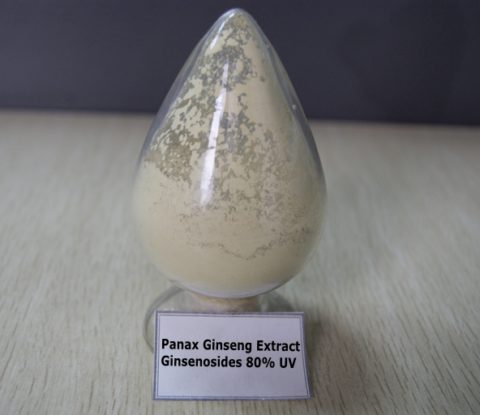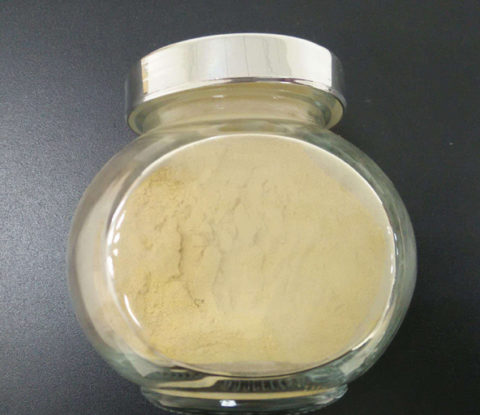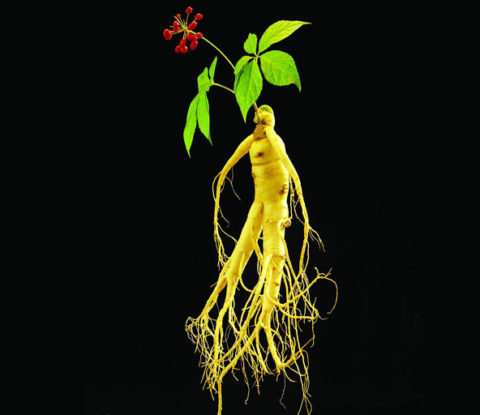
Panax Ginseng Extract
Panax Ginseng Root Extract Powder
【Latin name】: Panax ginseng C. A. Mey.
【Other names】: Ren Shen, Radix Ginseng, Ginseng, Chinese ginseng, Asian ginseng
【Product Specification】: 20% - 98% Ginsenosides,10:1,20:1
【Test method】: UV/HPLC/TLC
【Part used】: Root
【CAS NO.】: 90045-38-8
【Molecular formula】: C54H92O23
【Molecular weight】: 1109.29
【Product Appearance】: Brownish yellow to light brown powder
【Particle size】: 95% pass 80 mesh
Brief Introduction
Panax Ginseng (of the family Araliaceae), with synonyms of Korean Ginseng, Mountain Ginseng, True Ginseng, and Asian Ginseng (although this latter term refers to a few ‘Ginsengs’), is a plant that has been used in Traditional Chinese Medicine historically for a wide range of preventative purposes. It bears yellow-red berries (depending on cultivar) although the root is typically used in a powdered form for medicinal purposes.
Up to thirteen plants belong to the Panax genera, with only five of them used medicinally in traditional medicine. These include Panax Ginseng as well as American Ginseng (Panax quinquefolius, aka Xiyangshen) Vietnamese Ginseng Japanese Ginseng and Pseudoginseng. Of these five, Panax Ginseng is the most commonly used species medicinally, being used in 16.6% of the 3,944 prescriptions in the Korean Clinical Pharmacopoeia written in 1610 AD.
Panax Ginseng is a herb with the Species of ‘Panax’ and the Genera of ‘Ginseng’, and is the most commonly used medicinal Ginseng in this Genera. The term ‘Panax’ is derived from the Greek words for ‘all-healing’. ‘Ginseng’ has less complimenting origins, being an English translation of the chinese word rénshen meaning ‘man root’, although supposedly this was a reference to the roots of the plants looking like a man’s legs; therefore, a literal translation of Panax Ginseng into English is All-healing Man Root. The surface of the root is wrinkled and furrowed, and its taste is sweetish at first, with a somewhat bitter aftertaste.
Korean Red Ginseng
Korean Red Ginseng (KRG) is Panax Ginseng that is steamed and then dried, which appears to change some of the bioactive compounds. While Panax Ginseng tends to have Ginsenoside Rb1, Ro, and Re as the main components KRG touts Ginsenoside Rb(3) as the main bioactive. The latter can be metabolized to Ginsenoside Rb(2) (not unique to KRG) by intestinal bacteria, and KRG also possesses an Rg(3) content which is unique to KRG. Rb(3) and Rg(3) are seen as the main active ingredients of KRG, and the steaming and fermentation process favorably alters the Ginsenoside profile to favor these two. Further fermentation of already steamed/dried Red Ginseng, resulting in fermented Red Ginseng, further enhances the anti-inflammatory and anti-nocireceptive (pain-dulling) effects of it.
When looking at total Ginsenoside content, one study noted that KRG had equal to or higher levels of the main ginsenosides when compared to Panax Ginseng, which varied by source but this may not be the standard. In general, compounds sold commercially (Korean market) seem to vary from 0.5-1.1% ginsenosides by weight which tends to be lower than the averages for fresh ginseng.
Additionally, via Amadori rearrangements there can be formations of unique compounds during fermentation called arginyl-fructose and arginyl-fructosyl-glucose; these compounds show some promise in inhibiting carbohydrate uptake from the diet. These compounds also appear to bind to minerals (particularly copper) and exert anti-oxidative properties, and at least Arginyl-Fructose can be absorbed after oral administration to rats, with the other Amadori product possibly losing its glucose molecule and becoming Arginyl-Fructose. The total content of amadori products in Korean Red Ginseng is quite variable and dependent on steaming, and a study measuring 8 commerical products obtained in Korea noted between 0.85-2.51% for arginyl-fructose and 0.25-2.64% with arginyl-fructosyl-glucose.
White Ginseng
White Ginseng is a term used to refer to Panax Ginseng that has been cultivated and then air dried, as opposed to a steam drying to form Red Ginseng. The process of air drying follows peeling of the root and drying until the moisture content is below 12%, and turns the root into a yellow-ish white color. Some of the bioactives may be lost during this process.
Chemical Constituents
Panax Ginseng contains a variety of active components called ‘Ginsenosides’, which are steroid-like saponins that are unique to the Ginseng species (in regards to the chemical structure; not anabolic properties); well over 100 Ginsenosides exist, and the following list contains the major ones:
-Ginsenoside Ro at 20.1+/-0.4 (rhizome) and 2.2+/-0.4 (root) in mg/g ethanolic extract
-Ginsenoside Rb(1) 14.6+/-0.2 (rhizome) and 4.8+/-0.1 (root) in mg/g ethanolic extract
-Ginsenoside Rb(2) 5.5+/-0.1 (rhizome) and 2.0+/-0.4 (root) in mg/g ethanolic extract
-Ginsenoside Rc 7.1+/-0.5 (rhizome) and 2.6+/-0.2 (root) in mg/g ethanolic extract
-Ginsenoside Rd 2.5+/-0.2 (rhizome) and 0.2+/-0.2 (root) in mg/g ethanolic extract
-Ginsenoside Re 10.8+/-0.2 (rhizome) and 2.6+/-0.3 (root) in mg/g ethanolic extract
-Ginsenoside Rf 1.9+/-0.1 (rhizome) and 1.3+/-0.1 (root) in mg/g ethanolic extract
-Ginsenoside Rg(1) 7.1+/-0.5 (rhizome) and 2.6+/-0.2 (root) in mg/g ethanolic extract
The term Ginsenoside was conceived to describe a class of many molecules that are found in Ginseng; the term refers to steroidal saponins (structures with a dammarane steroid backbone, which is a chemical designation of structure; not to be confused with anabolic steroids) and are given a designation of Rx; the X being in reference to their movement on a TLC plate in vitro with A being most polar and H being least polar. Ginsenosides tend to be amphipathic as they inherently have a hydroxyl group on their backbone (polar) yet the backbone itself is non-polar.
Indications in TCM(Traditional Chinese Medicine)
1. Exhaustion syndrome due to qi deficiency
It is the most important herb in treating exhaustion syndrome because it powerfully reinforces original qi. For qi-exhaustion accompanied with extremely faint pulse tending to cease caused by heavily sweating, severe vomiting and diarrhea, or long and severe diseases, it can be used singly in large dosage, like Du Shen Tang in Jing Yue Quan Shu. For qi-exhaustion with some symptoms of yang-exhaustion, such as sweating, cold extremities, it is combined with other yang-restoring and collapse-rescuing herbs, such as Fu Zi in Shen Fu Tang recorded from Zheng Zhi Lei Yao (Classified treatment principles). For qi-exhaustion with some yin-exhaustion symptoms, such as sweating but warm body, thirst and desire for cold drink, dry and red tongue, etc. Though Ren Shen can promote generation of body fluid, it is combined with yin-nourishing herbs to promote the generation of body fluid and astringe sweat, for instance, it is used with Mai Dong and Wu Wei Zi in Shen Mai San from Nei Wai Shang Bian Huo Lun.
2. Spleen-qi and lung-qi deficiency syndrome
This herb is adept in tonifying spleen-qi, it is indicated for fatigue and mental fatigue, poor appetite and loose stool, or other symptoms caused by spleen-qi deficiency. It is often combined with spleen-tonifying herbs to dry the dampness or induce diuresis. For instance, it is used with Bai Zhu, Fu Ling in Si Jun Zi Tang from He Ji Ju Fang. For long-term diarrhea, proctoptosis, or ptosis of internal organs caused by sinking qi of middle energizer due to spleen qi deficiency, it is combined with qi tonics and yang-raising herbs. For instance, it is used with Huang Qi and Sheng Ma in Bu Zhong Yi Qi Tang from Pi Wei Lun. This herb has the action of keeping the blood flowing in the vessels through tonifying qi and it can be indicated for spleen qi deficiency with bleeding. It is often used with Huang Qi and Bai Zhu, as in Gui Pi Tang from Ji Sheng Fang.
This herb is also skilled in tonifying lung-qi. It is combined with herbs for relieving cough and dyspnea or tonifying lung-qi, and indicated for shortness of breath, dyspnea, no desire for talking or other symptoms due to lung-qi deficiency. For instance, it is used with Wu Wei Zi, Su Zi in Bu Fei Tang from Qian Jin Fang. Ren Shen has the action of tonifying both lung qi and kidney qi, thus it is indicated for dyspnea of deficiency type caused by lung qi deficiency and failure of kidney to receive qi absorption due to deficiency of lung and kidney qi. It is usually combined with herbs for tonifying lung and kidney so as to improve qi reception to relieve dyspnea. For instance, it is combined with Ge Jie or Hu Tao Ren respectively in Ren Shen Ge Jie San from Wei Sheng Bao Jian, or Ren Shen Hu Tao Tang from Ji Sheng Fang.
3. Both qi and yin deficiency syndrome, diabetes
This herb has the action of invigorating qi and promoting the generation of body fluid, it is indicated for thirst caused by both qi and body fluid injury during heat diseases or both qi and yin deficiency. For thirst and bit but weak pulse caused by both qi and yin injury during heat diseases, it is often combined with heat-clearing and fire-purging herbs. For instance, it is used with Zhi Mu, Shi Gao in Bai Hu Jia Ren Shen Tang from Shang Han Lun. For thirst, dry throat, fatigue and shortness of breath caused by both qi and yin deficiency, it is often combined with yin-nourishing herbs to promote the generation of body fluid, like in Sheng Mai San from Nei Wai Shang Bian Huo Lun. Commonly, the differentiation of diabetes shows as the fundamental aspect of the disease is yin deficiency, the incidental aspect of the disease is dry heat, and accompanied with qi and yin deficiency. Ren Shen can treat diabetes singly for it can both tonify qi and relieve thirst by nourishing yin. In clinic, for enhancing the effect, it is often combined with thirst-relieving and yin-nourishing and body-fluid generating herbs, such as Sheng Di Huang, Tian Hua Fen.
4. Blood deficiency syndrome, syndrome of both qi and blood deficiency
Because this herb can not only produce blood through tonifying qi but also can promote the generation of blood directly, it is indicated for blood deficiency syndrome, especially for deficiency of both qi and blood caused by qi deficiency failing to generate blood. It is often used with herbs that tonify qi and nourish blood. For instance, it is used with Dang Gui in Shen Gui Tang from Jing Yue Quan Shu for blood deficiency syndrome, and combined with Bai Zhu and Dang Gui in Ba Zhen Tang from Zheng Ti Lei Yao for both qi and blood deficiency.
5. Palpitation, insomnia, amnesia
This herb has the action of tonifying heart qi and induce tranquilization mind and improving the intelligence, so it is indicated for diseases caused by heart-qi deficiency or blood deficiency failing to nourish heart. For palpitation, knotted or intermitent pulse caused by heart-qi deficiency, it is often combined with heart-nourishing and tranquilization-inducing herbs, for instance, it is used with Suan Zao Ren, Bai Zi Ren in Zhi Gan Cao Tang from Shang Han Lun, or in Tian Wang Bu Xin Dan from She Sheng Mi Pou.
Pharmacological Effects
1.Fatigue and Endurance
A study in mice using a forced swim test noted that the polysaccharide content of Panax Ginseng may offer benefits to endurance via reducing fatigue, as administration of polysaccharides at 50, 100, and 200mg/kg bodyweight for 15 days noted that 1 hour after the last dose that only 200mg/kg bodyweight significantly improved performance. When the neutral polysaccharide fragment (40, 100, 160, and 200mg/kg) were compared against the acidic polysaccharide fragment, it was found that all doses of the acidic polysaccharides significantly improved performance and were the active ingredients (although the highest dose only of neutral polysaccharides also showed benefit). The acid fragment was more effective at enhancing circulating glucose, suppressing circulating TGs, and increased SOD expression relative to both the neutral fragment and unsupplemented control. Another study using 1, 10, and 100mg/kg in mice (10% Ginsenosides) failed to demonstrate a statistically significant improvement in forced swim time after 7 days of supplementation in mice (although trended towards significance).
2.Neurological benefits
1).General Cognition
A study in young healthy adults using 200 or 400mg acutely noted increased reaction time associated with 400mg, but not 200mg, 2.5 hours after ingestion. Interestingly, 200mg led to slightly but significantly slower reaction times on the first day of tested, which may have been secondary to an induction of calmess. These improvements in reaction time have been replicated with 400mg of 4% Ginsenoside extract (G115) in regards to spatial reaction time at the same time after ingestion, but only when combined with Ginkgo biloba did they reach statistical significance at 4 hours post ingestion for simple reaction time. A third test measuring reaction time noted some significant improvements, but most results were statistically insignificane; the results of this test may be secondary to anti-fatigue. The addition of Ginseng to Ginkgo appears to improve the parameters related to accuracy, and the ‘relaxing’ reports of Ginseng may reduce frequency of errors in cognitive tests. Another study by the same researchers tested 200mg and 400mg of G115 in healthy young adults found improved performance on the serial sevens subtraction task, a test for intellectual efficiency. Lesser inconsistent benefits were acheived on serial threes and on a reduction of errors in serial 3s, but little benefit was seen in reduction of errors in serial sevens.
2). Depression, Anxiety, Stress
In mice, 100mg/kg of the acidic polysaccharide fragment of Ginseng was able to decrease depressive symptoms in mice while improving social interactions and reducing aggression. 200mg/kg appeared to not be significantly effective on these parameters. Anti-depressive effects have been noted in mice given Ginsenosides as well, suggesting both main components of Ginseng are active regarding depression. Red Ginseng also appears to be effective, with either hydrolysis of Red Ginseng or acetate fermentation (fermented Korean Red Ginseng) being significantly more effective at exerting anti-depressive effects in mice relative to normal Red Ginseng.
In regards to stress, a possible mechanism may be altering genetic transcription of some enzymes. This study used pure saponin extracts in vitro at 10ug/mL and orally to rats at 200mg/kg noted that the mRNA levels of Tyrosine Hydroxylase and dopamine β-hydroxylase that was increased with stimuli was attenuated with Ginseng by 35.6 and 48.2% in adrenal glands (induced by stress) and 57.2% and 48.9% in neurons (induced by Nicotine), respectively.
3). Memory and Learning
When looking at Ginsenoside Rb1 in isolation, it appears to be responsible for enhanced learning rats in the hippocampus. It can enhance NGF-induced neurite growth in the ganglia of chicks, and when fed orally to rats at 2mg/kg daily for 30 days showed a decrease in acquisition phase of learning, suggesting that the enhanced memory seen later was secondary to better learning. This latter study failed to note any significant influence on motivation despite the enhanced learning, and after 30 days there was no significant difference in immunostaining of the hippocampus suggesting that no significant neurogenesis occurred.








